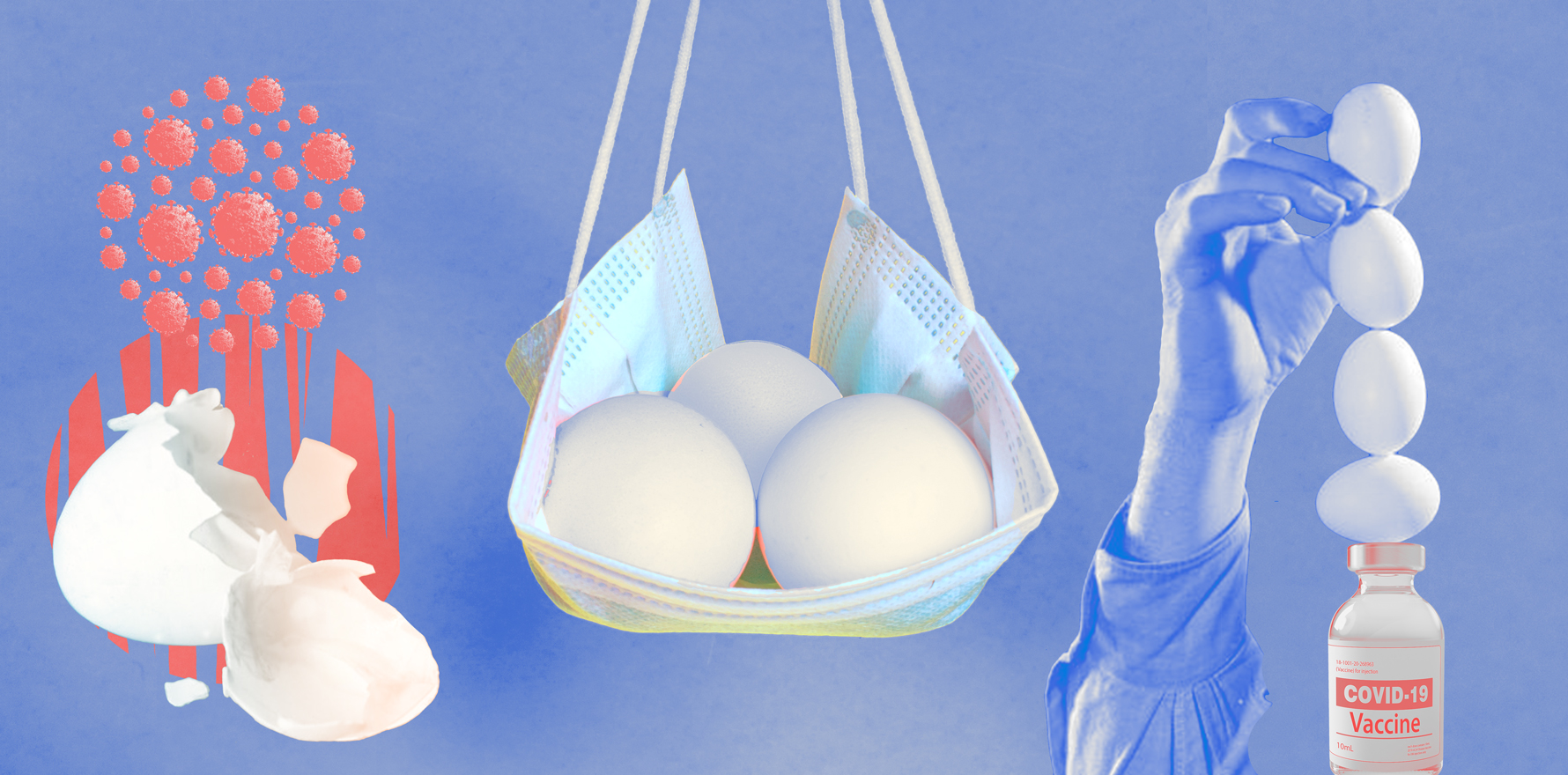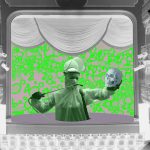We need to smarten up and not put all our eggs in the vaccination basket.
Eighteen months after the first cases of covid-19 in Australia, the Federal Government has announced the change of strategy from one based on suppression of virus transmission, to one based on developing herd immunity via mass vaccination.
It is hoped that completion of this will allow for a return to “near normal”.
Thus, our metaphorical eggs are now in the vaccination basket. Their early precedents are encouraging. Experience from the UK, US and Israel show that vaccination of around half the adult population can dramatically reduce rates of serious disease and mortality, even if it only dents the acquisition and transmission of new variants.
The percentage of the total population, adult and children, who will need to be vaccinated for this strategy to succeed has not been announced. A figure of around 75-80% is being suggested, although, given the extremely high transmissibility of the Delta variant, it may be higher. However, both experiences overseas and surveys here show that around 75% is a likely maximum for public compliance.
While this may change with time as the consequences of non-vaccination become clearer, it is always more difficult to get the last 20%, rather than the first 20%, fully vaccinated. Additionally, it is likely that as vaccination immunity wains and new variants arise, we will require additional top-ups and boosters to maximise protection. In many parts of the world, where vaccination rates are low and social conditions limit suppression, waves of infections will continue to provide new variants that will leak through borders.
It is likely that in the longer term, pretty much everyone will either get the disease or get vaccinated. A challenging thought. There is little doubt that development of immunity via vaccination is preferable, and potentially broader, safer, and clinically more effective than immunity via virus infection itself. In the longer term, it’s also likely many will get multiple vaccinations and covid infections, before we finally reach some long-term equilibrium as exists for other community viruses.
Putting too many of our eggs into this one vaccination basket is not without its risks. It is important to continue to explore additional and synergistic options, especially those aimed at preventing transmission, rather than limiting the processes of infection itself.
During the pandemic, our ideas of how this virus is transmitted have changed. Any summary should be pre-empted by noting that many important details are currently unclear. What we have are better models of what best explains observations, aided by experiments that provide limited insights.
What we (mostly) know
First, it appears SARS-CoV-2 is largely spread via the invisible cloud of particles of respiratory fluid we expel when we speak, cough or breath. Most, but not all, transmission occurs between people in close proximity; that is, less than 1-2 metres apart. We literally breathe each other’s air.
Second, transmission via surfaces and touching is probably less common than first thought, and hand washing and “deep cleaning” have little impact on community transmission. Opinion on this remains divided.
Third, community transmission almost always occurs within enclosed spaces; for example, houses, schools, shops, planes, ships, transport vehicles, offices, bars, gyms, choir halls, prisons, nursing homes etc.
Transmission outdoors is uncommon but still occurs. For example, a sheltered outdoor bar with crowds loudly talking face to face would not be regarded as safe just because it is outdoors. Similarly, while people may be spaced within a sports stadium, they are closely packed when at gates, bathrooms, in a bar and shouting. If you can smell or feel someone’s breath when they are talking to you, you are definitely in the zone where their exhaled plume is reaching your breathing zone.
It is now apparent that even transitory close proximity in indoor spaces can be sufficient to allow transmission to occur. This is not common, fortunately. When pattens of transmission to multiple people within aircraft, restaurants and other venues are examined, they sometimes show scattered distribution, with some close people escaping, while more distant ones are infected. Why transmission occurs in one instance and not others in the same location is not clear. Presumably, the devil will be in the details of activity, emission, exhaling, inhalation, airflow patterns etc.
As noted, while transmission usually occurs between people in close proximity, it can also occur over distances of many metres when people are grouped together in enclosed spaces with poor ventilation. This has been observed in halls, planes, buses, school rooms, office buildings, restaurants, etc. Some have been termed “superspreading events” (a possibly misleading term) and there are now over a thousand examples. In these situations, exhaled particles from the infected person accumulate in the air, and over time transmit disease over many metres. Similarly, the exhaled plume containing airborne virus can move between rooms, across corridors and through unfiltered air conditioning systems of buildings. While the concept of “infectious dose” is useful, it is a complex and unclear amalgam of virus concentration and quantity, particle size, time, host susceptibility and luck. This remains an uncertainty.
It is important that the current understanding of transmission is used to generate and refine strategies as we learn to live with the complexities of having a circulating pathogenic virus in the community.
Mask up
First, commercial masks are small miracles; they both filter small particles while still being easy to breathe through. They can do this because the filters are constructed of a non-woven and dense mesh of fine fibres that carry an electrostatic charge, acting like magnets for particles. Masks both reduce the exhaled plume of virus-laden air from an infected person by filtration and deflection, and secondly, they reduce the amount of virus in the inhaled air. Even simple cloth masks, worn by both people, provide something like a five-fold protection.
With better-quality commercial masks, this joint factor can rise to over a 100-fold protection. There is the ongoing need for masks with good filtration and comfort, better fit and that are reusable. In high-risk settings, fit-tested respirators (N95 masks) are required.
Clear the air
Second, we urgently need standards for air quality in indoor spaces based on the provision of fresh (that is, virus-free) air. It is a paradox that everyone is required to sign in and sanitise their hands on entry to a bar, gym, restaurant etcetera (high-risk spaces because of talking, shouting and exercise-breathing at close quarters), only to then occupy a space with unknown and typically low rates of air exchange greatly increasing the risk of infection.
Have we learnt nothing?
The quantity of carbon dioxide in uncontaminated outdoor air is 420 parts per million (ppm). The suggested guide for occupied indoor spaces is under 1000ppm; it is not uncommon for crowded venues such as schools to exceed averages of 2000, with peaks of 3000ppm. While carbon dioxide does not equate to virus concentration, it is a proxy marker based on air exchange rate, occupancy and activity, all of which are determinants of likely virus exposure. Devices to measure CO2 cost a few hundred dollars and enable us to start to easily monitor ventilation.
Another way to think about ventilation is in terms of air changes per hour. Hospital wards have 10 to reduce transmission of infections, while modern houses and offices often less than one. While there are energy costs in providing fresh air, the cost of transmission risk needs to be considered as well.
In buildings, air that has been adequately filtered can serve as a substitute for fresh air, with the emphasis on “adequate”, as many industrial air filters are not designed to effectively remove particles of the size that carry viruses. This provision of fresh or filtered air should be extended to all people working in fixed locations with high public exposure, thus bus and cab drivers, box office attendants etc should be supplied with their own source of fresh or filtered air in their local workspace. Having a small screen between people and customers has been shown to have little effect on exposure as virus aerosols pass these around. Clean air is an OH&S issue.
It is noteworthy that in the US, the current administration has allocated US$136 billion ($186 billion) – with another US$165 billion pending – to improving air quality in educational institutions by multiple measures, including installing CO2 monitors, upgrading filters, setting standards for fresh air supply and monitoring compliance. This would be regarded as a novel intervention here and yet this is a direction that we should be moving in. The US has taken on board that transmission is airborne and we need safe work and learning spaces.
If studies of influenza transmission in institutions are a guide, then the irradiation of the upper levels of rooms with UV light greatly reduces transmission. UV of specific wavelength 222nm is safe for humans and destructive of viruses. Again, this could be considered in crowded spaces.
Keep track
Third, improving contact tracing. Experience has shown that initial attempts using blue-tooth proximity software (COVIDSafe) have not proved adequate. State-based systems using QR code log-in at venues provide broad data about who was in a location, such as a shop or shopping centre, over an approximate time, often several hours as often people don’t log out. One advantage is that compliance is high, but the data has limited resolution of time and space. Further, the definitions of casual and close contacts differ by state. The consequences of being identified are quite onerous, (e.g., “close contact” requires testing and isolation for 14 days regardless of results).
The technology to better resolve location within minutes and metres exists, but its implementation is delayed by a legal framework surrounding individual privacy. Issues include where the data is stored, who owns and can access the data, and how long the data is stored for. Recognising this, the West Australian government recently brought in overnight legislation to ensure that QR code data could be used only for health, not criminal-related, matters.
Faster tests
Rapid saliva-based, self-administered rapid tests (like pregnancy tests) seems worthy as their specificity and sensitivity improves. This could provide inexpensive mass-screening at many critical locations within the community where full testing is not done; for example, workplaces, recreation, borders etc. Results are available in 10-15 minutes; any positives would be referred to more specific tests (PCR).
Currently there is a reluctance to introduce these, partly because Australia considers itself a low-prevalence country. Such tests are supplementary and additive; they do not replace existing technology.
We mustn’t slack off now
We have done some things brilliantly as a society. But in others we have fallen short, as have many other countries in their own way. Our response has been marked by a lack of trust of expert data, lack of sustained investment in long-term research and confusion within decision-making processes. Examples are the reluctance to accept so-called aerosol transmission, the use of inadequate PPE for healthcare workers and quarantine, and our national lack of deep expertise in production of masks and vaccines. Our experts have struggled for piecemeal funding in all these areas.
This has been costly in terms of outbreaks and preventable infections. Covid is like 9/11 in that it forever changes the future and we need to deepen our long-term response.
In the past 20 years, there have been several “novel” viruses; there will be others, plus their variants. Their transmission and epidemics are directly related to how we live and behave as social animals. We will eventually learn to adapt to this one, both immunologically and socially, but the price may be high and the time-frames long.
Mass vaccination is perhaps our most powerful weapon, and we must refine and encourage vaccination. But we would be foolish to rely on this and not employ other ways to mitigate transmission. The more we can avoid infection, the better.
At present, methods for avoidance of infection include masks, social distancing, high rates of ventilation, air filtration, use of UV, hand hygiene, contact tracing, access to rapid virus testing to identify asymptomatic cases and supporting people to isolate and stay at home. All could be improved. In particular, there are both micro and macro changes we can make to our built environment that could emulate the safety of the outdoors and further reduce transmission.
The virus called SARS-CoV-2 is here to stay.
Euan Tovey is an associate professor and honorary affiliate senior research fellow at the Woolcock Institute, University of Sydney (these are his views), with special interests in virus transmission and sampling biological aerosols.





